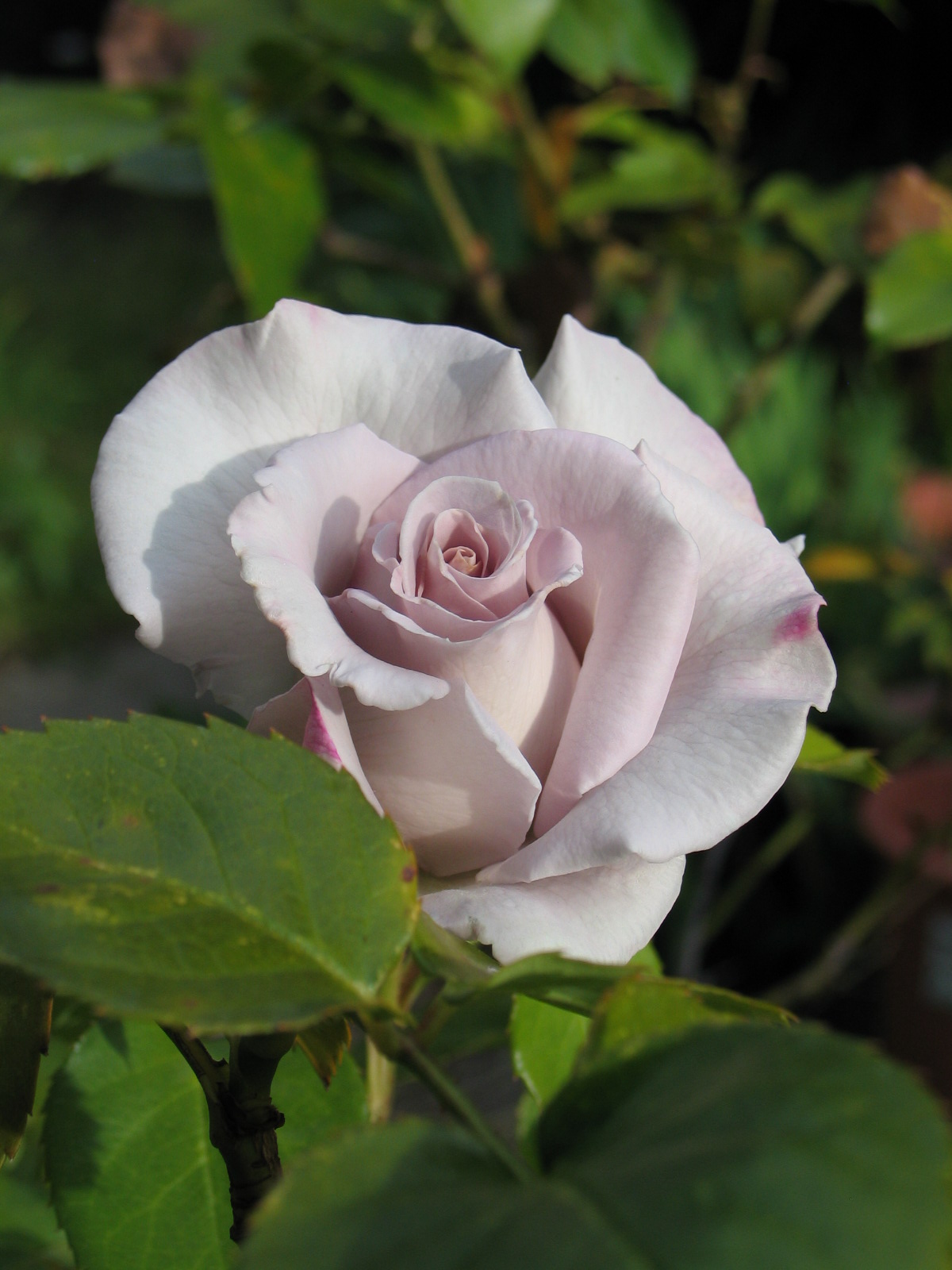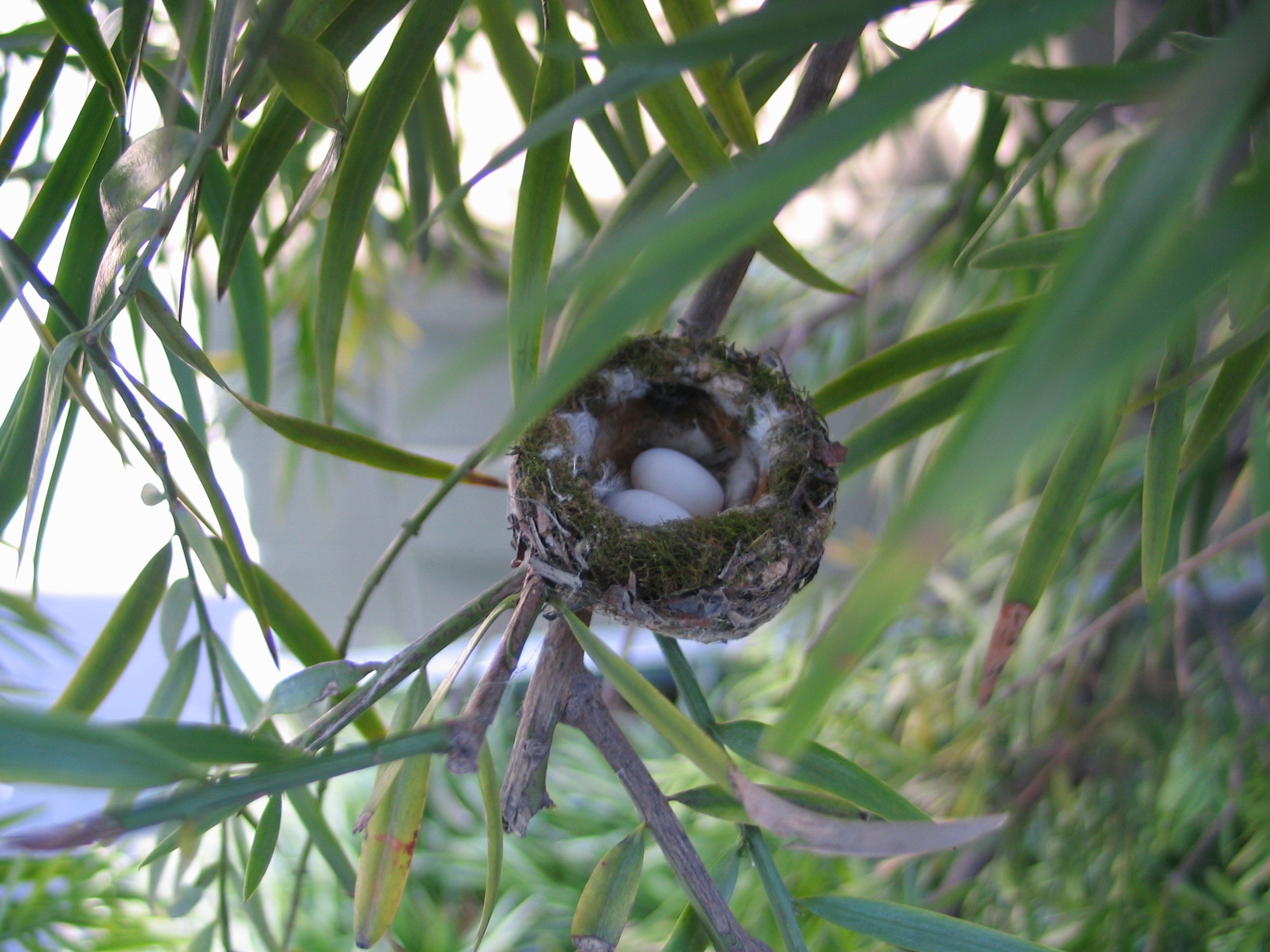You've heard that you should water trees deeply and infrequently, right? I take that approach a bit further and use it for everything - trees, perennials, roses, everything. I'm careful with my water anyway having grown up in Los Angeles during the 70's drought when we let our yellows mellow, removed or reduced lawns, and collected shower water.See, we're in for some serious growing pains while we struggle to understand and adjust to mandatory water restrictions now in 2015 - I don't need to repeat the advice, you already know it (ditch the lawn, add compost and mulch, etc). But what we need to be doing is more than just using less water, we need to use water more wisely - to help our plants fend for themselves better. I see water as a training tool and my plants as smart, but slow. They can't fetch and training them to do much of anything takes years.As of my last water bill, I'm down to 36 GPD (gallons per day) including landscaping. Before you bow in awe to this amazing feat, you should know that I irrigate my garden a little differently than most and I'm not watering anything I don't want to keep. Let the rest die, they're out of here anyway. Here's where I water differently: I bought a 15 gal. Magnolia 'Black Tulip' (that baby green tree in the background left-side). It is rated as having "moderate" water needs in Oakland by WUCOLS. Moderate isn't exactly water-wise, but I've got a theory..... and so far, so good. I planted the tree a year ago this month. At the same exact time, my client in Mill Valley had three planted (guess whose idea that was). Their landscape contractor did exactly what they usually do - they amended, fertilized, and watered the hell out of those trees. My client's trees bloomed and grew and leafed out beautifully, gained stature nicely. Mine didn't. Luckily for them, theirs are next to a lawn that I'm sure they'll keep as long as they can, where I have no lawn. Below is a better shot of mine last May (1 month after planting).I planted mine with a bit of compost, watered it in well that first day, and walked away. It looked fine for a while, then it got all stressed out and started dropping leaves. I watered it again, a nice soaking, and it threw out some new leaves. We did this all summer: I kept an eye on it, watering only when I found signs of stress in the leaves, but then not again until I saw more stress. It was nerve-wracking. The tree did not visibly thrive, and it sure as heck didn't get much bigger. I'm pretty sure it would slap me if it could.... but it survived. While it was dormant over winter and I held my breath to see how it would do come spring. This spring when it started blooming, I was delighted with how many (albeit smallish) flowers there were on my young tree, and now it is leafed-out for the season. I'll be doing the same this summer, soaking the presumably larger root-zone, but as seldom as possible. I'll also be adding more compost on top (not working it in, that's the worms' job) and maintaining a good layer of mulch over that.I believe that what I am doing will be better for my tree's long-term durability. I believe that I gave it reason to throw energy into its root system in search of water, and that I rewarded deep root growth instead of fast, exciting foliage and gains in stature. Over the winter, its root system likely continued to dive and while I watered, soaking further and further down but less and less often, we're working together to train this "moderate" water needs tree to survive more like a drought tolerant tree. Here it is today, not much bigger, but doing just fine:I don't water fast enough that it trickles off, doing by hand what irrigation designers call "cycle and soak", making sure that the water goes into the soil and nowhere else. I'm also taking advantage of the few light rains we had to water further than the rain itself went = deep watering every time.I can't tell others to do this, the tree looked like hell that first year of establishment and I think most people wouldn't watch closely enough nor would they enjoy the experience (even I was a bit nervous). We'll see how things go this summer, but I can tell you that I don't water much, maybe once a month? I avoid watering if it is overcast or cool outside. I look closely at my plants in the most stressful times - when it is blazing hot, sunny, and/or dry and windy. If I see stress, I'll water. If not, forget it. I'll keep you posted on how things go this summer.The most impressive thing, though, is what I noticed in putting together this post - look how much my roses LOVE this treatment - they get watered only when the tree gets watered and I have yet to see them look even a little stressed. You can see the change best between the second photo and the one above. They're the hybrid tea 'Stainless Steel' (my favorite). Here's the original one (now on the right in the photo above) blooming in my old garden in Alameda in 2010 and again in 2012:
Oh, Lantana, How You Vex Me!
The front of my new place is awash with purple Lantana (Lantana montevidensis). It is lovely stuff if you are both color blind (unless you're into this sort of purple, nothing wrong with that!) and an admirer of wildlife. There are butterflies, bees, spiders, and lizards all over it. It is absolutely marvelous for year-round blooming and needs no supplemental water once established (at least not here, I turned the irrigation off last fall).The flowers are the pepto bismol of purples - not my favorite, though maybe someday I will find a companion plant with a color that mitigates the pepto purple hue. Meh, maybe not. A dear friend of mine said that the overwhelming amount of purple Lantana in my garden made my place look like a retirement home.As much as I'd like to be able to retire (I'd still spend my time designing gardens - I love it that much), I am not ready to live in a dadgum retirement home! Talk about death by association; I can't look at it anymore without thinking about retirement homes. As if that wasn't bad enough, my lovely boyfriend thinks the foliage smells like poo (the flowers smell nice at night). Charming: a poo scented retirement home.Here's my vexation: as much as I intend to remove the Lantana and put in other stuff, it is happy, healthy, requires no water, and supports oodles of critters. So for now it stays.... providing food and shelter for all those bugs and lizards, but lookout, Lantana! You're living on borrowed time. Wanna know what I think might fill the space above? I'm considering a collection of spineless Opuntia that my friend Melinda sent me from Texas along with a few I've collected on my own here. The ones from Texas are rooting in the shed right now - cross your fingers that they all take!So there's my dilemma - removing the Lantana removes habitat, but goodness gracious, there's so danged much of it, I don't really like it, and the new design/plants aren't ready yet. Patience....
Hello, little companions!
We share the garden, period. Sharing is caring.
Read more"Low Maintenance" Gardens?
It seems that everyone is aware that gardens can require some effort to maintain. Professionals in the landscape design and construction industry understand that the success of any outdoor space depends on thoughtful design, quality installation, and ongoing, intelligent maintenance. Not one of these three items can deliver the desired result without the other two.
Read moreWater use's not-so-obvious issues
I am sorry to say that despite the incredible amount of coverage that water use gets these days, almost none discusses some of the long-term effects of inappropriate watering practices. I am not going to start counting how many gallons you can save by switching to drip irrigation, or the fact that spray irrigation can lose 50% to the wind and evaporation before your plants get any of it....nope, I'm not. I do want to mention a few things that I've learned through being a Landscape Architect and a gardening enthusiast:Roots: I read a letter to the editor in our glorious Alameda Journal (23 october 2009) in which a woman complains about street tree roots buckling her walkway. I have not seen her property, but I would bet a whole lot of donuts that the problem can be traced back to shallow irrigation. Roots know what they're doing, they take up water and nutrients for the plant (tree, shrub, whatever). They will go where the water is, and if the good stuff is to be found in the top layer of the soil, that is where you will find the roots. This goes for a tree, a shrub, all plants including a lawn. So when your sprinkler system is on for 10 minutes and soaks in maybe 3", or you stand outside with a hose for half an hour, you can expect the majority of roots to gravitate to that topmost layer, including those of walkway-bucking trees.Here's the part I wish those water-wise articles would mention: IF you water your plants deeply and less frequently, their root systems learn to dive deep to find it. Even a lawn can have roots that are a couple of feet deep! Water deeply, and the water lasts longer, is available to the roots of your plants, and then when there is a drought, those plants have a better survival rate thanks to their deep, probing root structure!!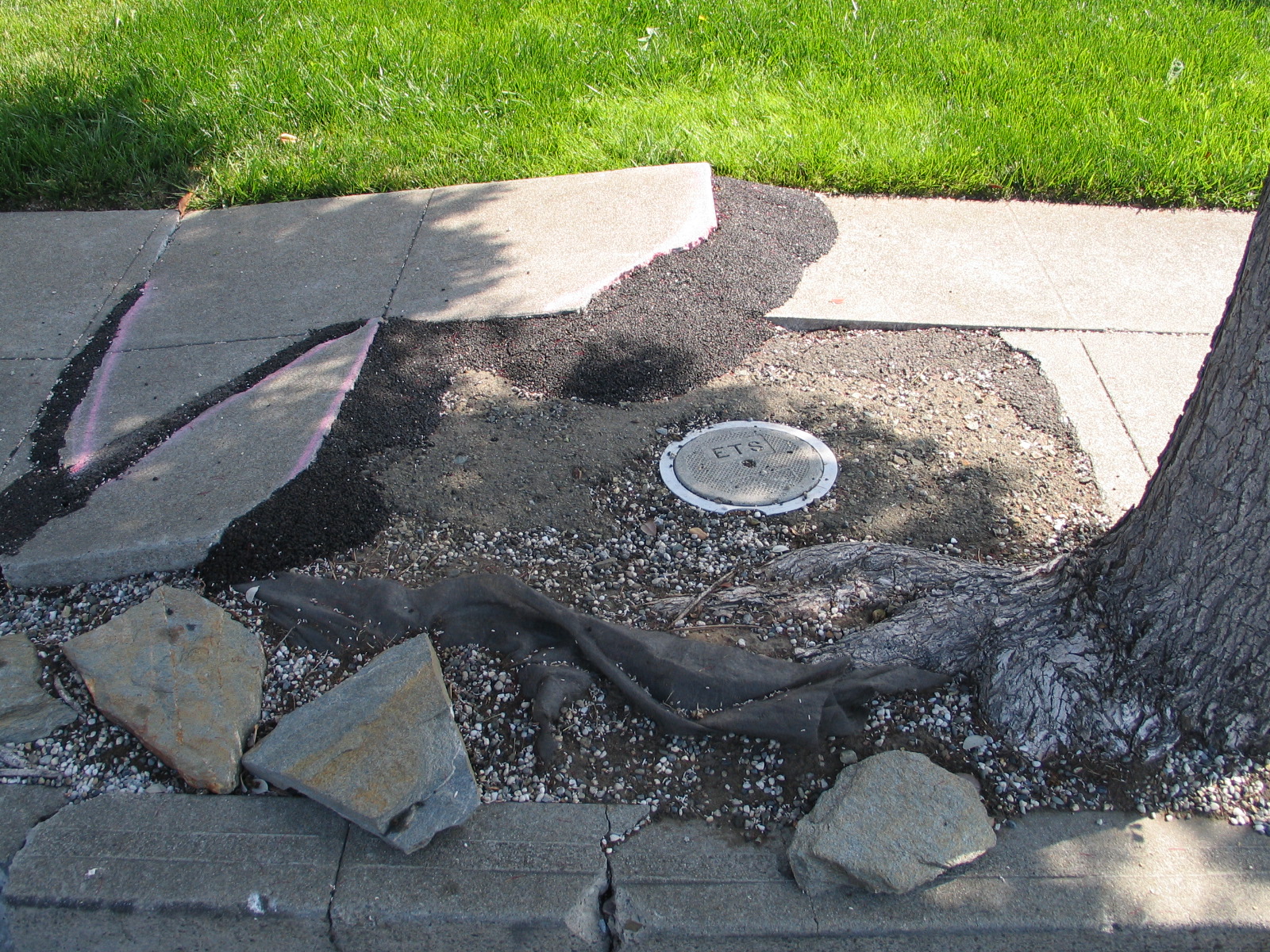 Containers: I prefer terracotta pots for the numerous ways in which they have been a good home to my plants over time (oh yeah, this is about water, not pots... I'm getting back on track now). Whatever containers you use, when the root ball dries out, it shrinks and pulls away from the sides. The next time water is poured into that container, the water runs around the rootball (not through) and out the bottom, doing the roots of your plants no good. There are goofy weird products on the market that claim to hold moisture in the soil, or add water over time, blah blah. I've tried many and never liked one. In my garden, I have a 1/8" thick wire stake of forgotten origin that I use to poke holes into the rootballs of neglected container plants when I water. The holes allow air to escape, water to penetrate, and roots to get what they need. If I have been particularly rotten to my container plants, I fill a bucket or my wheelbarrow with water and I soak them in it to allow them to really soak it up. A note: I don't think self-watering containers work well. The photo below shows a lovely display from the Los Angeles Getty Museum gardens several years ago - I wonder, though, are they hand-watered? is the water allowed to drain out? Was I just lucky enough to see this display before that water stained the paving? Container plants need water and drainage in order to stay nice for more than a short time.
Containers: I prefer terracotta pots for the numerous ways in which they have been a good home to my plants over time (oh yeah, this is about water, not pots... I'm getting back on track now). Whatever containers you use, when the root ball dries out, it shrinks and pulls away from the sides. The next time water is poured into that container, the water runs around the rootball (not through) and out the bottom, doing the roots of your plants no good. There are goofy weird products on the market that claim to hold moisture in the soil, or add water over time, blah blah. I've tried many and never liked one. In my garden, I have a 1/8" thick wire stake of forgotten origin that I use to poke holes into the rootballs of neglected container plants when I water. The holes allow air to escape, water to penetrate, and roots to get what they need. If I have been particularly rotten to my container plants, I fill a bucket or my wheelbarrow with water and I soak them in it to allow them to really soak it up. A note: I don't think self-watering containers work well. The photo below shows a lovely display from the Los Angeles Getty Museum gardens several years ago - I wonder, though, are they hand-watered? is the water allowed to drain out? Was I just lucky enough to see this display before that water stained the paving? Container plants need water and drainage in order to stay nice for more than a short time.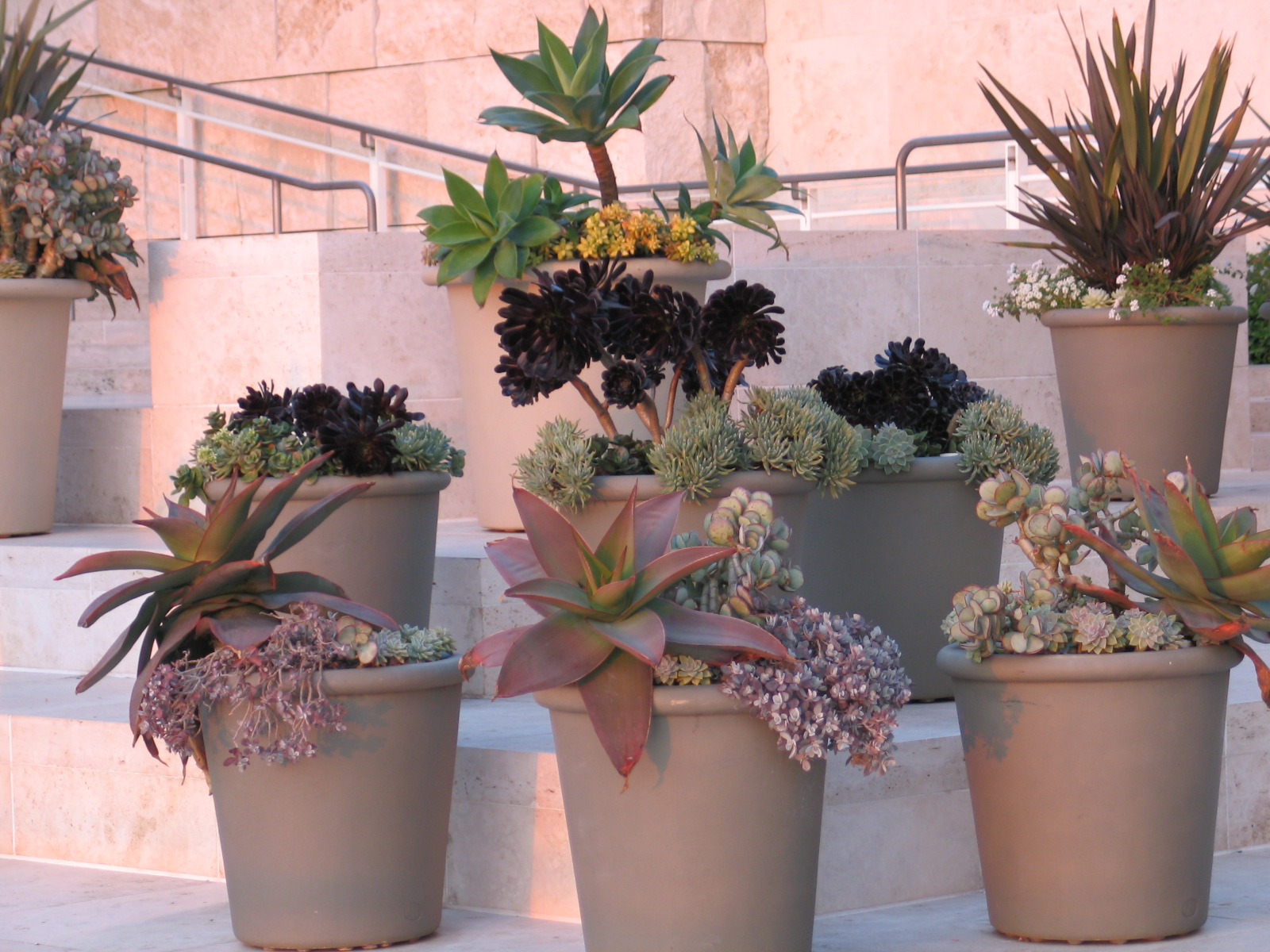 Watering Practices: I love walking around in the evening, winding down after my day. I see a lot of irrigation at night, though, and wish that more people understood the benefits of watering in the early am instead. Plants lose most of their moisture during the heat of the day as a byproduct of photosynthesis (evapotranspiration from photosynthesis is where plant-released oxygen comes from), so watering before plants need it is ideal (but if you have wilting, dry plants at noon, they need it asap!). If you have good drainage, so much the better because the (assuming we're not growing aquatic plants) roots won't be left to wallow in suffocating muck. Leaving plant roots in cool, damp soil as the temperature drops (evening watering) can promote the growth of undesirable mold, fungus, and plant disease. Please also pay attention to the drainage of your soils! The water here is pooling due to being both trapped by the edging and also because the soil in this area is so over watered, it has developed a scummy skin that keeps their irrigation efforts on the surface for hours after each watering.Please know that there are evapotranspiration (ET) irrigation systems that can adjust automatically (with the help of a weather station) to turn the water off when it is raining, adjust for seasons, soils, slopes, and planting types! You do NOT have to rely on remembering to run out in the rain to turn the thing off or waiting for your maintenance service to do it for you.
Watering Practices: I love walking around in the evening, winding down after my day. I see a lot of irrigation at night, though, and wish that more people understood the benefits of watering in the early am instead. Plants lose most of their moisture during the heat of the day as a byproduct of photosynthesis (evapotranspiration from photosynthesis is where plant-released oxygen comes from), so watering before plants need it is ideal (but if you have wilting, dry plants at noon, they need it asap!). If you have good drainage, so much the better because the (assuming we're not growing aquatic plants) roots won't be left to wallow in suffocating muck. Leaving plant roots in cool, damp soil as the temperature drops (evening watering) can promote the growth of undesirable mold, fungus, and plant disease. Please also pay attention to the drainage of your soils! The water here is pooling due to being both trapped by the edging and also because the soil in this area is so over watered, it has developed a scummy skin that keeps their irrigation efforts on the surface for hours after each watering.Please know that there are evapotranspiration (ET) irrigation systems that can adjust automatically (with the help of a weather station) to turn the water off when it is raining, adjust for seasons, soils, slopes, and planting types! You do NOT have to rely on remembering to run out in the rain to turn the thing off or waiting for your maintenance service to do it for you.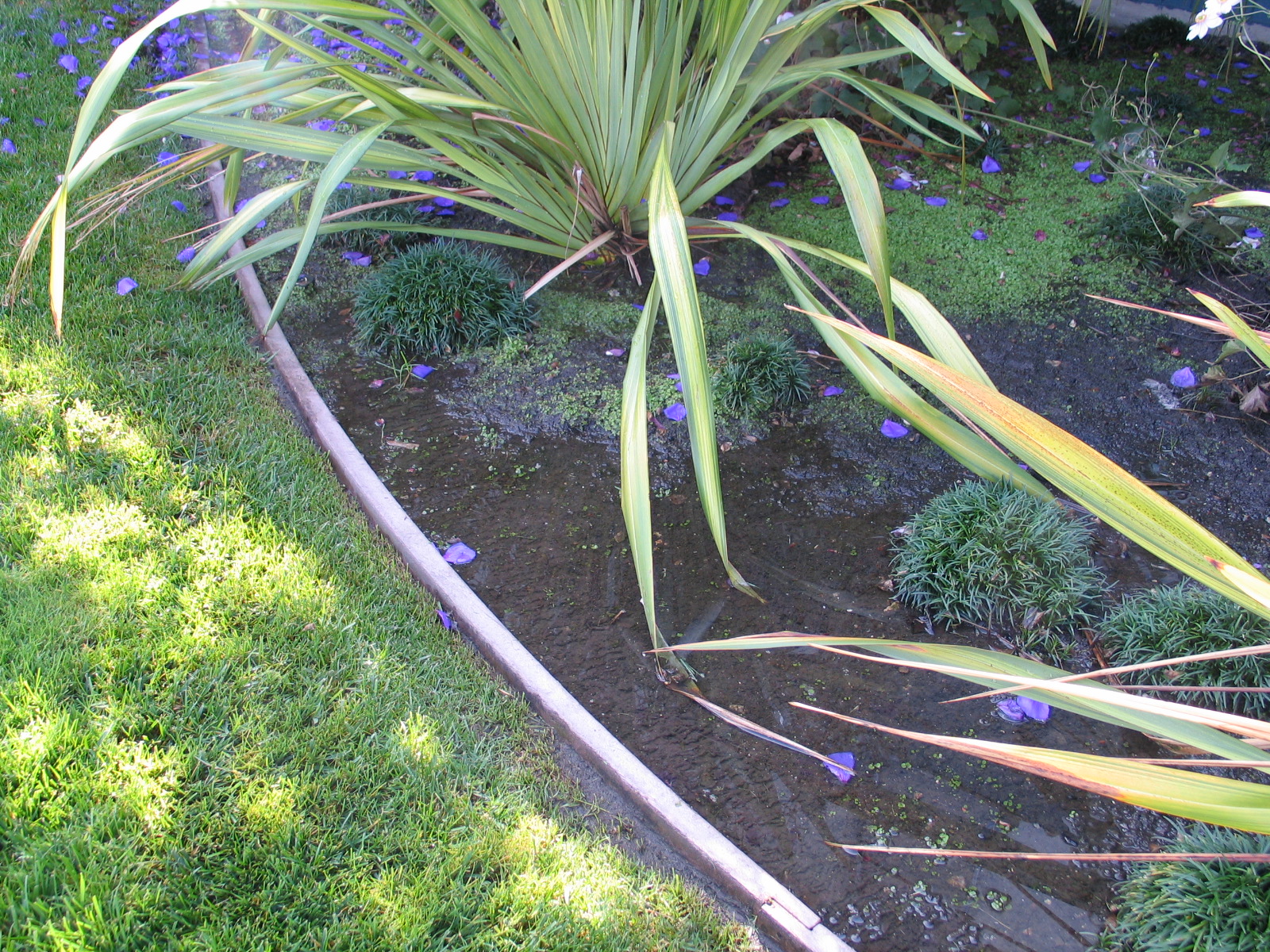 Runoff: Okay, so we've talked about water and your vegetation, and we know that we don't want to water the sidewalk, but what about all that flooding that we get in a good storm? Permeable paving products hope to help solve the problem, see this report adopted by the California Coastal Commission in March, 2007. I would point out, however, that permeable paving solutions are dependent on proper maintenance, and that even compacted soil can resist water penetration as well as any hard paving material. So, not to get into a discussion of style or design, I would encourage everyone to consider where a permeable solution can be used. It is far nicer to have all that lovely rainwater seep into the soil than to run off our urban and suburban surfaces, filling up the storm drains instead. I was given this book on Rain Gardens as a gift about a year ago, it is worth reading. I bring up runoff, because I've noticed several water-saving lists recommending adding non-planted areas to cut down on the amount of water needed to irrigate. I think that suggesting this is misleading and not necessarily an environmentally friendly practice.
Runoff: Okay, so we've talked about water and your vegetation, and we know that we don't want to water the sidewalk, but what about all that flooding that we get in a good storm? Permeable paving products hope to help solve the problem, see this report adopted by the California Coastal Commission in March, 2007. I would point out, however, that permeable paving solutions are dependent on proper maintenance, and that even compacted soil can resist water penetration as well as any hard paving material. So, not to get into a discussion of style or design, I would encourage everyone to consider where a permeable solution can be used. It is far nicer to have all that lovely rainwater seep into the soil than to run off our urban and suburban surfaces, filling up the storm drains instead. I was given this book on Rain Gardens as a gift about a year ago, it is worth reading. I bring up runoff, because I've noticed several water-saving lists recommending adding non-planted areas to cut down on the amount of water needed to irrigate. I think that suggesting this is misleading and not necessarily an environmentally friendly practice.
Water conservation in the landscape - the obvious stuff.
If you have read anything online, or watched the news, or read a paper in the last decade, you already know that water use and conservation is an issue in our state. Things that can save water include:* mulching* grouping plants into water-use zones, and using drought tolerant plants that are adapted to your area* switching from a typical sprinkler system to drip irrigation or sub-grade irrigation* Watering in the early am (not late at night, please!!! that actually promotes pathogens) so the plants can take up the water in time for the warm day ahead.* cleaning sidewalks and driveways with a broom instead of a hose (well, duh)
Read moreMixed lawns - alternatives to turfgrass
Lawn daisies
Even if you don't go to the expense and trouble of removing an existing lawn regardless of its condition, simply overseeding with white clover can start a remarkable transformation. Adding clover to your turfgrass lawn can begins the transformation of adding little flowers, benefits from nitrogen fixing, and gaining a more textured, greener appearance.
Read moreLawns: what they're good for or not...
twin houses 1
When asked about turf grass lawns, some clients feel that they should have one but cannot provide a particular reason. "Because they're nice" someone once said to me. I don't think that is reason enough if there's no functional or aesthetic need for it. If a lawn fills a particular emotional need or is meaningful in some way, that is a different story. Unfortunately, the care required to keep them healthy makes turf grass lawns one of the least environmentally friendly growing things you can have.
Read more



